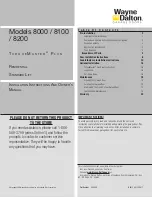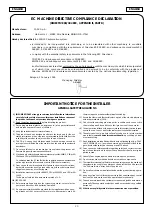
4
HD272 Installation Instructions
Entrapment Zones for a
Pull-To-Open Application
Gate in the
Open Position
Gate in the
Open Position
ZONE 2
ZONE 3
ZONE 4
ZONE 5
Driveway
ZONE 1
ZONE 2
ZONE 4
ZONE 5
ZONE 3
I. Before Installation
1. Verify this operator is proper for the type and size of gate,
frequency of use and class of the gate system.
2. Make sure the gate has been properly installed and swings
freely in both directions. Repair or replace all worn or
damaged gate hardware prior to installation. A freely moving
gate will require less force to operate and will enhance the
performance of the entrapment protection devices used with
the system (see
Prepare the Gates
3. Review the operation of the system to become familiar with
its safety features. Understand how to disconnect the operator
for manual gate operation (see page 3).
4. The gate and operator installation must comply with any
applicable local codes.
5. This gate operator is intended for vehicular gates only. A
separate entrance or gate must be installed for pedestrian use
(see page 8).
6. Always keep people and objects away from the gate and its
area of travel. No one should cross the path of a moving gate.
7. Identify all of the entrapment zones for the type of
installation. An entrapment zone is an area around the
automatic gate system where a person or object could be
caught that increase the risk of injury. Entrapment zones must
be eliminated, guarded or protected.
8. When designing a system that will be entered from a highway
or main thoroughfare, make sure the gate system is placed far
enough from the road to prevent traffic congestion.
For the Installer and End User
Important Safety Information
WARNING
To reduce the risk of injury or death:
1.
READ AND FOLLOW ALL INSTRUCTIONS.
2. Never let children operate or play with gate controls. Keep
the remote control away from children.
3. Always keep people and objects away from the gate.
NO
ONE SHOULD CROSS THE PATH OF THE MOVING
GATE.
4. Test the gate operator monthly. The gate MUST reverse on
contact with a rigid object or stop when an object activates
the non-contact sensors. After adjusting the force or the limit
of travel, retest the gate operator. Failure to adjust and retest
the gate operator properly can increase the risk of injury or
death.
5. Use the manual/emergency release only when the gate is not
moving.
6.
KEEP GATES PROPERLY MAINTAINED
. Read the
user’s manual. Have a qualified service person make repairs
to gate hardware.
7. The entrance is for vehicles only. Pedestrians must use
separate entrance.
8. The gate must be installed in a location that provides
adequate clearance between it and adjacent structures
when opening and closing to reduce the risk of entrapment.
Swinging gates must not open into public access areas.
9.
SAVE THESE INSTRUCTIONS.









































